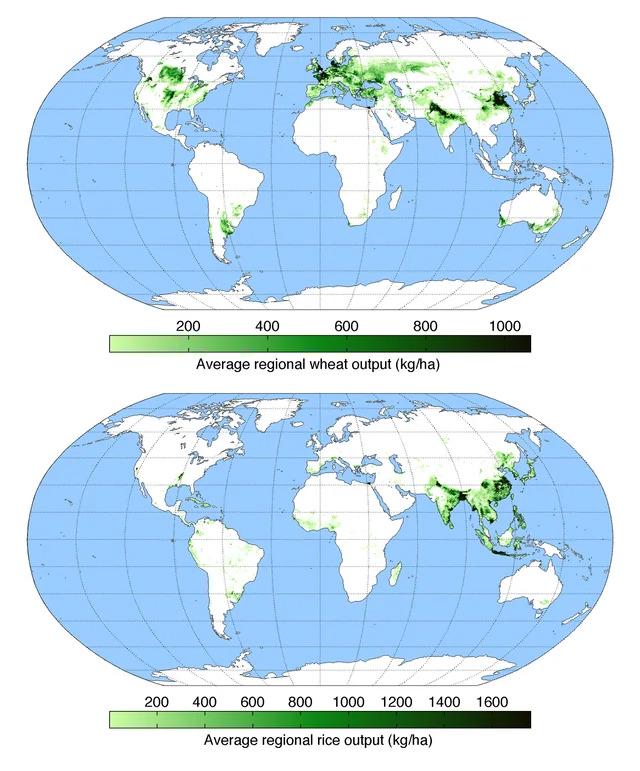Wheat vs Rice Map: Global Cultivation Areas Map


David Chen
Data Visualization Specialist
David Chen is an expert in transforming complex geographic datasets into compelling visual narratives. He combines his background in computer science ...
Geographic Analysis
What This Map Shows
The "Wheat vs Rice Map: Global Cultivation Areas" illustrates the primary regions around the world where these two staple crops are predominantly grown. Wheat and rice are not only crucial for food security but also serve as cultural staples in many societies. This map highlights the geographical distribution of these crops, revealing the climates and conditions that favor their cultivation.
Interestingly, while both crops are vital for sustenance, they thrive in markedly different environments. Wheat is often associated with temperate climates, whereas rice is primarily cultivated in tropical and subtropical regions. This visualization serves as a gateway to understanding agricultural practices, dietary preferences, and economic dependencies across different countries.
Deep Dive into Wheat and Rice Cultivation
Wheat and rice are two of the most significant grains in the world, feeding billions of people daily. Globally, wheat is the second most-produced cereal after corn, while rice holds the title for the most consumed staple food. The cultivation of these grains is influenced by various factors, including climate, soil type, and water availability.
Wheat is predominantly grown in regions with temperate climates, where seasonal variations in temperature and rainfall can support its growth cycle. Major wheat-producing countries include China, India, the United States, and Russia. In fact, according to recent statistics, China and India alone contribute to nearly half of the world’s wheat production. Wheat thrives in well-drained soils and often requires less water than rice, making it a more sustainable option in arid regions.
Rice, on the other hand, is primarily cultivated in Asia, with China, India, Indonesia, and Bangladesh being the leading producers. What’s fascinating is that rice requires a significant amount of water, which is why it is often grown in flooded fields known as paddies. This method not only helps to control weeds but also provides the necessary moisture for rice plants. The map indicates that Southeast Asia is a rice powerhouse, with countries like Vietnam and Thailand also playing crucial roles in global rice production.
In terms of yield, rice production is highly labor-intensive, especially in regions where traditional farming methods are still prevalent. However, advancements in agricultural technology and improved seed varieties have led to increased yields, which are vital for feeding the growing global population.
Regional Analysis
Looking at the map, it’s clear that wheat and rice cultivation is not uniformly distributed across the globe. In North America, for example, the United States is a major wheat producer, largely due to its vast plains and favorable growing conditions. In contrast, the southern states are more inclined towards rice cultivation, thanks to the humid subtropical climate.
In Europe, countries like France and Germany are known for their wheat production, while Italy and Spain also contribute to both wheat and rice outputs, particularly in their northern regions where climatic conditions are favorable.
Asia, however, is the epicenter for rice cultivation. Countries such as China and India dominate global rice production, while nations like Thailand and Vietnam have emerged as significant exporters. Interestingly, the rice production in these countries is supported by a complex system of irrigation that has been refined over centuries.
In Africa, wheat is increasingly being cultivated in regions like Egypt and Ethiopia, where climate conditions are becoming more favorable for wheat production. Meanwhile, rice is gaining traction in West African countries, with initiatives aimed at improving local production to reduce reliance on imports.
Significance and Impact
Understanding where wheat and rice are grown is crucial for several reasons. First and foremost, these crops play a vital role in global food security. As the world’s population continues to rise, the demand for these staple foods will only increase. Furthermore, the cultivation practices associated with each crop have significant environmental impacts. For instance, rice farming is often associated with methane emissions due to anaerobic decomposition in flooded fields, raising concerns about its contribution to climate change.
Moreover, fluctuations in wheat and rice production due to climate change, trade policies, and market demands can have far-reaching consequences on global food prices and availability. Countries that rely heavily on imports for these staples may face challenges in ensuring food security, especially in times of crisis.
In terms of future projections, advancements in agricultural technology, such as genetically modified organisms (GMOs) and precision farming, may play a pivotal role in enhancing yields and sustainability. As we navigate through the complexities of climate change and population growth, understanding the geographical distribution of these key crops will remain essential for policymakers, farmers, and consumers alike.
In conclusion, the "Wheat vs Rice Map" not only depicts where these crops are grown but also opens a window into the agricultural practices, environmental considerations, and socio-economic factors that shape global food systems today.
Visualization Details
- Published
- September 27, 2025
- Views
- 60
Comments
Loading comments...